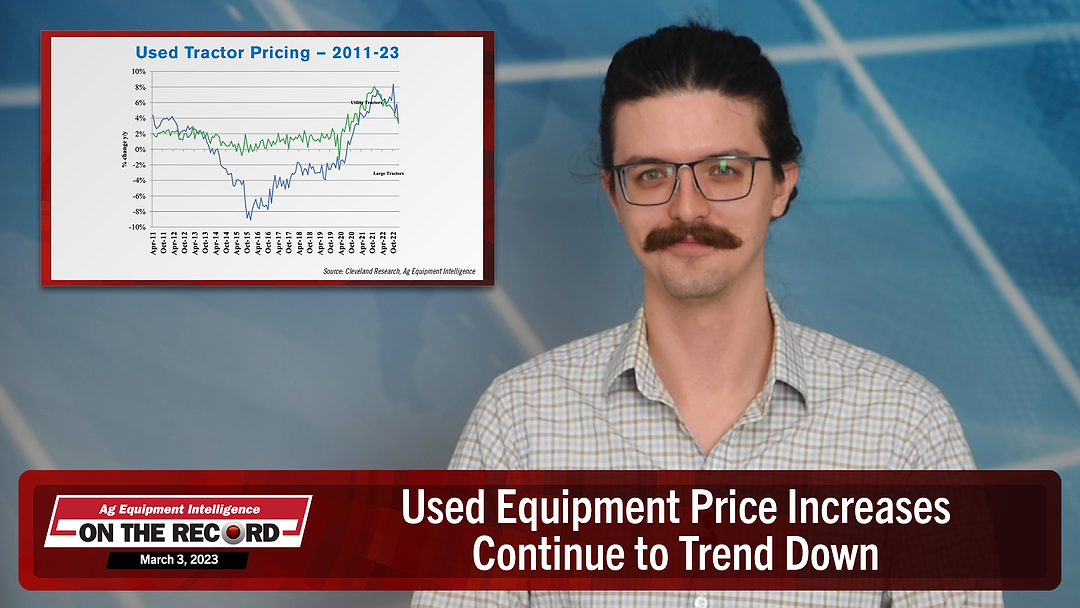In this episode of On the Record, we discuss how dealers are seeing used equipment price increases continuing to trend downward. In the Technology Corner, Noah Newman reports on Case IH debuting its new AFS furrow command technology at this year's National Farm Machinery Show. Also in this episode, a look at John Deere's forecast for restocking their dealers and no-till farmers' equipment purchasing plans.

This episode of On the Record is brought to you by BENZI.
BENZI delivers innovative solutions for power transmission. For 60 years we have been manufacturing PTO drive shafts, torque limiters, gearboxes, speed multipliers and speed reducers for agricultural mechanization. Our products are designed and tested to grant maximum performances in every working environment and our product range is by far the widest available on the market covering the vast majority of all power requirements and applications for agricultural PTO driven equipment
TRANSCRIPT
Jump to a section or scroll for the full episode...
- Used Equipment Price Increases Continue to Trend Down
- Dealers on the Move
- Technology Corner: Case IH Debuts New AFS Furrow Command Technology
- Deere Says Dealers Will See Restocking in 2024
- Large Farms Generated 46% of 2021 U.S. Production Value
- No-Tillers Forecast for Higher Equipment Purchases & Interest Expenses
- DataPoints: Off-Farm Income
Used Equipment Price Increases Continue to Trend Down
According to Ag Equipment Intelligence’s latest Dealer Sentiment & Business Conditions Update, dealers are continuing to report a slowdown in used equipment price increases. Though all equipment categories saw used price increases up year-over-year in January, all categories saw month-over-month declines in the rate of price increase or remained unchanged.

Used 4WD tractor pricing showed the most notable month-over-month decline, reporting a 3% year-over-year price increase vs. a 7% increase in December. Used row-crop tractor pricing was up 4% year-over-year in January, down from a 5% increase in December.

Used combine pricing remained unchanged month-over-month, with January showing a 4% year-over-year price increase.

The net percentage of dealers reporting their used equipment inventories as “too low” has remained around the 50% mark for the last 4 months. In the latest update, a net 52% of dealers reported used equipment inventory as too low vs. the net 50% who said the same in December. A net 16% of dealers said their used combine inventories specifically were too low in December, and 69% said the same for their high horsepower tractor inventory.
Dealers on the Move
This week’s Dealer on the Move is Parallel Ag.
Newly formed dealership group Parallel Ag announced March 1 it had sold its Omaha, Neb., location, bringing the dealership to 12 stores. Parallel Ag was formed in Dec. 2022 through the merging of shortline Midwest applicator dealer Ag Solutions Group and AGCO Southern Plains dealer Livingston Machinery
Case IH Debuts New AFS Furrow Command Technology
Case IH made its presence felt at the National Farm Machinery Show last month, introducing its new AFS Furrow Command technology suite, which includes downforce automation.
Case IH seeding marketing manager Trent Nowosad says AFS Furrow Command downforce automation will take down-pressure settings on their Precision Disk Air drills to the next level.
“The system does a number of things. Of course, it makes it a lot easier to set that down pressure. It also allows us to have superior seed placement because it allows us to deal with variabilities in the field such as hard soil or uneven residue spreads. When the drill encounters that (field variabilities) the system will react. And thirdly, above all, it will allow us to reduce the maintenance costs because we’re always setting the right down pressure for the conditions. We’re not overapplying it which can cause extended wear on coulters, scrapers and gauge wheels.”
AFS Furrow Command downforce automation hits the market this spring. We’ll have more from the Case IH booth on the Farm Innovations YouTube channel.
Deere Says Dealers Will See Restocking in 2024
During its first quarter 2023 earnings call, John Deere executives discussed their forecasts for dealer inventory restocking. General consensus was that dealers won’t see relief until 2024.
Director of Investor Relations Brent Norwood said:
“For large ag, our dealers remain on allocation as we have mentioned. The vast majority of orders are marked for retail and have a customer name associated with them. So we don’t expect to see restocking of dealer inventory this year. You will see some channel inventory build seasonally a bit as we ramp up production ahead of the season, but we don’t predict much change in dealer inventory year-over-year by our fiscal year-end. We expect any restocking to be more of a 2024 story.”
Norwood stated later in the presentation that many dealers are fully expecting some products to remain on allocation into 2024. He also said dealers’ inventory to sales ratio for 220 plus horsepower tractors is about 14%, where it would normally be in the mid 20% to low 30% ratio at this point in a typical year.
When asked during the Q&A portion of the call about fleet age in 2023, Norwood said it depends on the product line but that tractor age will likely remain the same, saying:
“If we meet our production goals, this year tractors will sort of maintain their age. They won’t age up further, but they really won’t get younger. We pointed this out before in the past. Our production levels in 2023 are still 20-25% below prior replacement cycles. So, as a result, we will likely just maintain large tractor age in 2023. We will make a little bit of progress on combines pulling down the age a bit, but I would note that, the ending point for this year is still above sort of the average fleet age over a longer period of time.”
Large Farms Generated 46% of 2021 U.S. Production Value
Large-scale family farms operated 27% of agricultural land and were responsible for 46% of the total value of production in 2021, according to a Feb. 27 report from USDA.

These large-scale farms, defined as having gross cash farm income over $1 million, made up 3% of total farms in the U.S. in 2021. On the other hand, small farms, which have less than $350,000 in gross cash farm income, made up 89% of farms and operated 45% of agricultural land, making up 18% of total production value.
Non-family farms, including partnerships of unrelated partners, nonfamily corporations and farms with a hired manager unrelated to the owners, were the smallest group, making up 2% of all farms. This group of farms, however, operated 10% of all agricultural land and made up 17% of total 2021 production value.
No-Tillers Forecast for Higher Equipment Purchases & Interest Expenses
No-Till Farmer’s 15th annual benchmark study of no-till practices conducted in late 2022 found no-till farmers planning more equipment purchases than last year. 2022 was a strong year for no-tillers: a record 92% reported making a profit, up from 91% in 2021 and the highest percentage in the survey’s 15-year history.

Some of no-till farmers’ equipment purchases and planned purchases hit levels not seen in years. Over 17% of no-tillers said they have purchased or plan to purchase a tractor in 2023, up from 13.3% who said the same for 2022 and a 9-year high. Another 8.4% said they plan to buy a drill in 2023, which represents a 10-year record high. The least common purchase among no-tillers was for forage harvesters with 0.5% of no-tillers planning a purchase.

Surveyed no-tillers estimated their expenses for 2023 will total about $413 per acre, totaling $487,891 across the average operation. No-tillers predicted their highest 2023 expenses will be loan payments and interest at an average of $78,567, up from over $59,000 for 2022. This was only the second time in the last 8 years that no-till farmers’ loan payments and interest was their highest forecast annual expense.
Fertilizer was the second-highest forecast expense at $77,119 for the year, though this was down from the $78,000 and $86,000 no-tillers forecast for 2022 and 2021 respectively.
DataPoints: Off-Farm Income
This week’s DataPoint is brought to you by the Dealer Success Academy.

For most U.S. farm households, off-farm sources are the main sources of income. In 2021, earnings from farming accounted for an estimated 23% of the average income of farm operators households, with most of the balance coming from wages earned by farm operators and their spouses.
On the Record is now available as a podcast! We encourage you to subscribe in iTunes, the Google Play Store, Soundcloud, Stitcher Radio and TuneIn Radio. Or if you have another app you use for listening to podcasts, let us know and we’ll make an effort to get it listed there as well.
We’re interested in getting your feedback. Please feel free to send along any suggestions or story ideas. You can send comments to bthorpe@lessitermedia.com.







